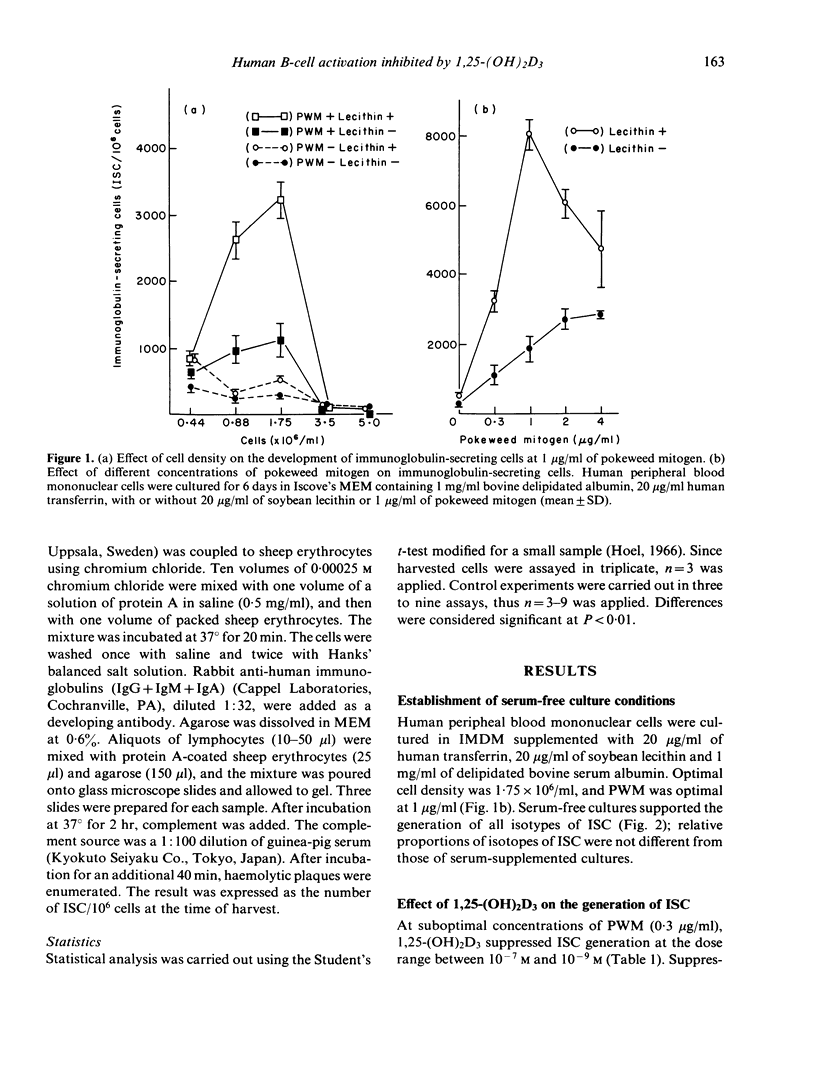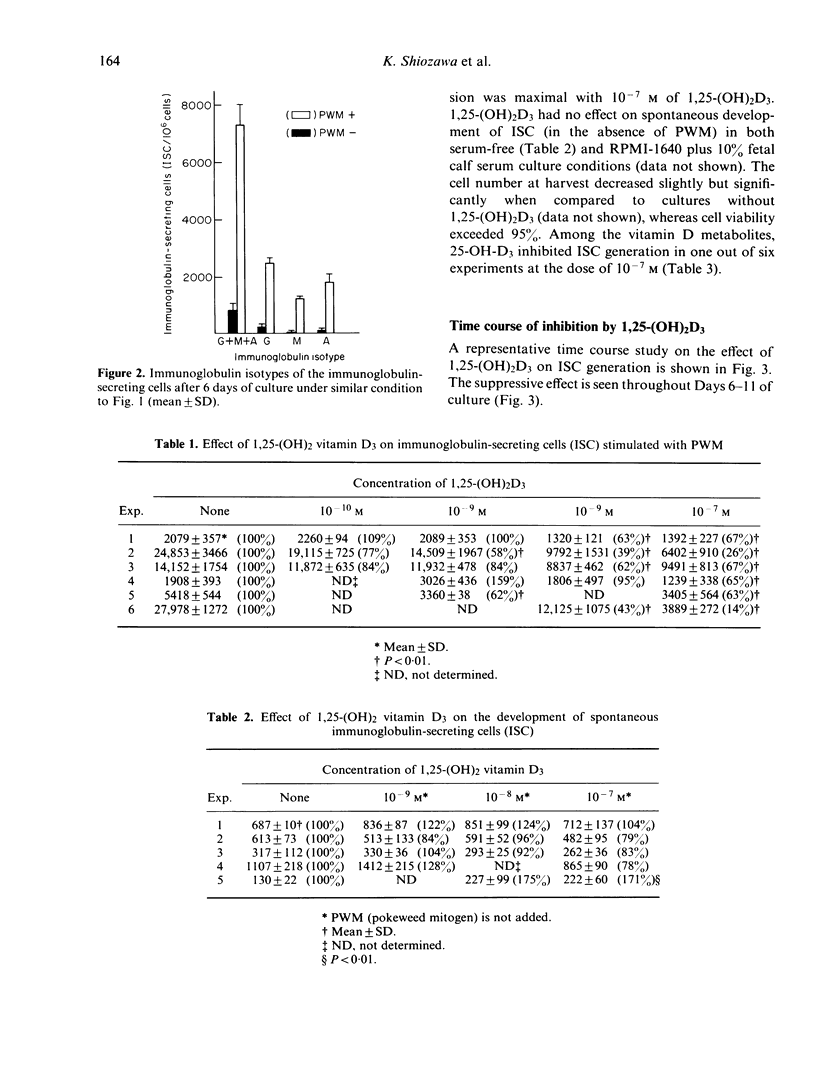Abstract
The effect of 1 alpha,25-dihydroxyvitamin D3 (1,25-(OH)2D3) on pokeweed mitogen-induced generation of human immunoglobulin-secreting cells (ISC) was studied in serum-free culture. Human peripheral blood mononuclear cells (1.75 X 10(6)/ml) were cultured in 200 microliter microculture wells containing Iscove's MEM supplemented with 20 micrograms/ml of human transferrin, 20 micrograms/ml of soybean lecithin and 1 mg/ml of delipidated bovine albumin. The culture supported ISC generation of all isotypes, and the optimal concentration of pokeweed mitogen was 1 microgram/ml. After stimulation with a suboptimal concentration (0.3 micrograms/ml) of pokeweed mitogen, 1,25-(OH)2D3 suppressed the ISC generation at a dose range between 10(-9) M and 10(-7) M, and maximal inhibition was obtained at 10(-7) M. 1,25-(OH)2D3 had no effect on the spontaneous ISC generation. The effect was specific for 1,25-(OH)2D3 and no suppression was obtained by 24R,25-dihydroxyvitamin D3 or 25-hydroxyvitamin D3.
Full text
PDF






Selected References
These references are in PubMed. This may not be the complete list of references from this article.
- Abe E., Miyaura C., Sakagami H., Takeda M., Konno K., Yamazaki T., Yoshiki S., Suda T. Differentiation of mouse myeloid leukemia cells induced by 1 alpha,25-dihydroxyvitamin D3. Proc Natl Acad Sci U S A. 1981 Aug;78(8):4990–4994. doi: 10.1073/pnas.78.8.4990. [DOI] [PMC free article] [PubMed] [Google Scholar]
- Amento E. P., Bhalla A. K., Kurnick J. T., Kradin R. L., Clemens T. L., Holick S. A., Holick M. F., Krane S. M. 1 alpha,25-dihydroxyvitamin D3 induces maturation of the human monocyte cell line U937, and, in association with a factor from human T lymphocytes, augments production of the monokine, mononuclear cell factor. J Clin Invest. 1984 Mar;73(3):731–739. doi: 10.1172/JCI111266. [DOI] [PMC free article] [PubMed] [Google Scholar]
- Bhalla A. K., Amento E. P., Clemens T. L., Holick M. F., Krane S. M. Specific high-affinity receptors for 1,25-dihydroxyvitamin D3 in human peripheral blood mononuclear cells: presence in monocytes and induction in T lymphocytes following activation. J Clin Endocrinol Metab. 1983 Dec;57(6):1308–1310. doi: 10.1210/jcem-57-6-1308. [DOI] [PubMed] [Google Scholar]
- Bouillon R., Van Assche F. A., Van Baelen H., Heyns W., De Moor P. Influence of the vitamin D-binding protein on the serum concentration of 1,25-dihydroxyvitamin D3. Significance of the free 1,25-dihydroxyvitamin D3 concentration. J Clin Invest. 1981 Mar;67(3):589–596. doi: 10.1172/JCI110072. [DOI] [PMC free article] [PubMed] [Google Scholar]
- Brenner M. K., Newton C. A., North M. E., Weyman C., Farrant J. The interaction of specific T-cell help and non-specific B-cell growth factors in the production of anti-tetanus antibody by human B cells grown in serum-free microcultures. Immunology. 1983 Nov;50(3):377–385. [PMC free article] [PubMed] [Google Scholar]
- Chen R. F. Removal of fatty acids from serum albumin by charcoal treatment. J Biol Chem. 1967 Jan 25;242(2):173–181. [PubMed] [Google Scholar]
- Colston K., Colston M. J., Feldman D. 1,25-dihydroxyvitamin D3 and malignant melanoma: the presence of receptors and inhibition of cell growth in culture. Endocrinology. 1981 Mar;108(3):1083–1086. doi: 10.1210/endo-108-3-1083. [DOI] [PubMed] [Google Scholar]
- Farrant J., Newton C. A., North M. E., Weyman C., Brenner M. K. Production of antibody by human B cells under serum-free conditions. J Immunol Methods. 1984 Mar 30;68(1-2):25–34. doi: 10.1016/0022-1759(84)90133-9. [DOI] [PubMed] [Google Scholar]
- Ginsburg W. W., Finkelman F. D., Lipsky P. E. Circulating and mitogen-induced immunoglobulin-secreting cells in human peripheral blood: evaluation by a modified reverse hemolytic plaque assay. J Immunol. 1978 Jan;120(1):33–39. [PubMed] [Google Scholar]
- Gronowicz E., Coutinho A., Melchers F. A plaque assay for all cells secreting Ig of a given type or class. Eur J Immunol. 1976 Aug;6(8):588–590. doi: 10.1002/eji.1830060812. [DOI] [PubMed] [Google Scholar]
- Iscove N. N., Melchers F. Complete replacement of serum by albumin, transferrin, and soybean lipid in cultures of lipopolysaccharide-reactive B lymphocytes. J Exp Med. 1978 Mar 1;147(3):923–933. doi: 10.1084/jem.147.3.923. [DOI] [PMC free article] [PubMed] [Google Scholar]
- Jelinek D. F., Lipsky P. E. The role of B cell proliferation in the generation of immunoglobulin-secreting cells in man. J Immunol. 1983 Jun;130(6):2597–2604. [PubMed] [Google Scholar]
- Lemire J. M., Adams J. S., Sakai R., Jordan S. C. 1 alpha,25-dihydroxyvitamin D3 suppresses proliferation and immunoglobulin production by normal human peripheral blood mononuclear cells. J Clin Invest. 1984 Aug;74(2):657–661. doi: 10.1172/JCI111465. [DOI] [PMC free article] [PubMed] [Google Scholar]
- Linke R. P., Zucker-Franklin D., Franklin E. D. Morphologic, chemical, and immunologic studies of amyloid-like fibrils formed from Bence Jones Proteins by proteolysis. J Immunol. 1973 Jul;111(1):10–23. [PubMed] [Google Scholar]
- Miyaura C., Abe E., Kuribayashi T., Tanaka H., Konno K., Nishii Y., Suda T. 1 alpha,25-Dihydroxyvitamin D3 induces differentiation of human myeloid leukemia cells. Biochem Biophys Res Commun. 1981 Oct 15;102(3):937–943. doi: 10.1016/0006-291x(81)91628-4. [DOI] [PubMed] [Google Scholar]
- Polet H., Spieker-Polet H. Serum albumin is essential for in vitro growth of activated human lymphocytes. J Exp Med. 1975 Oct 1;142(4):949–959. doi: 10.1084/jem.142.4.949. [DOI] [PMC free article] [PubMed] [Google Scholar]
- Spieker-Polet H., Polet H. Identification of albumin as the serum factor essential for the growth of activated human lymphocytes. J Biol Chem. 1976 Feb 25;251(4):987–992. [PubMed] [Google Scholar]
- Tsai K. S., Heath H., 3rd, Kumar R., Riggs B. L. Impaired vitamin D metabolism with aging in women. Possible role in pathogenesis of senile osteoporosis. J Clin Invest. 1984 Jun;73(6):1668–1672. doi: 10.1172/JCI111373. [DOI] [PMC free article] [PubMed] [Google Scholar]
- Tsoukas C. D., Provvedini D. M., Manolagas S. C. 1,25-dihydroxyvitamin D3: a novel immunoregulatory hormone. Science. 1984 Jun 29;224(4656):1438–1440. doi: 10.1126/science.6427926. [DOI] [PubMed] [Google Scholar]


